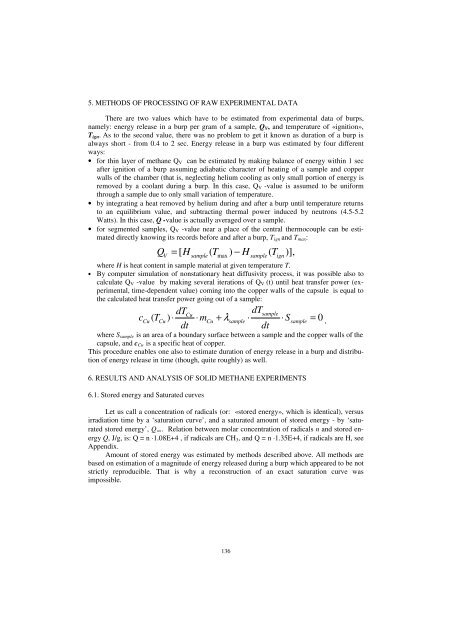Druck-Materie 20b.qxd - JUWEL - Forschungszentrum Jülich
Druck-Materie 20b.qxd - JUWEL - Forschungszentrum Jülich
Druck-Materie 20b.qxd - JUWEL - Forschungszentrum Jülich
You also want an ePaper? Increase the reach of your titles
YUMPU automatically turns print PDFs into web optimized ePapers that Google loves.
5. METHODS OF PROCESSING OF RAW EXPERIMENTAL DATA<br />
There are two values which have to be estimated from experimental data of burps,<br />
namely: energy release in a burp per gram of a sample, QV, and temperature of «ignition»,<br />
Tign. As to the second value, there was no problem to get it known as duration of a burp is<br />
always short - from 0.4 to 2 sec. Energy release in a burp was estimated by four different<br />
ways:<br />
• for thin layer of methane QV can be estimated by making balance of energy within 1 sec<br />
after ignition of a burp assuming adiabatic character of heating of a sample and copper<br />
walls of the chamber (that is, neglecting helium cooling as only small portion of energy is<br />
removed by a coolant during a burp. In this case, QV -value is assumed to be uniform<br />
through a sample due to only small variation of temperature.<br />
• by integrating a heat removed by helium during and after a burp until temperature returns<br />
to an equilibrium value, and subtracting thermal power induced by neutrons (4.5-5.2<br />
Watts). In this case, Q -value is actually averaged over a sample.<br />
• for segmented samples, QV -value near a place of the central thermocouple can be estimated<br />
directly knowing its records before and after a burp, Tign and Tmax:<br />
Q = [ H ( T ) − H ( T )],<br />
V sample max sample ign<br />
•<br />
where H is heat content in sample material at given temperature T.<br />
By computer simulation of nonstationary heat diffusivity process, it was possible also to<br />
calculate QV -value by making several iterations of QV (t) until heat transfer power (experimental,<br />
time-dependent value) coming into the copper walls of the capsule is equal to<br />
the calculated heat transfer power going out of a sample:<br />
dT<br />
dT<br />
Cu<br />
sample<br />
cCu ( TCu) ⋅ ⋅ mCu + λsample<br />
⋅ ⋅ Ssample<br />
= 0,<br />
dt dt<br />
where Ssample is an area of a boundary surface between a sample and the copper walls of the<br />
capsule, and cCu is a specific heat of copper.<br />
This procedure enables one also to estimate duration of energy release in a burp and distribution<br />
of energy release in time (though, quite roughly) as well.<br />
6. RESULTS AND ANALYSIS OF SOLID METHANE EXPERIMENTS<br />
6.1. Stored energy and Saturated curves<br />
Let us call a concentration of radicals (or: «stored energy», which is identical), versus<br />
irradiation time by a ‘saturation curve’, and a saturated amount of stored energy - by ‘saturated<br />
stored energy’, Q∞.. Relation between molar concentration of radicals n and stored energy<br />
Q, J/g, is: Q = n ⋅1.08E+4 , if radicals are CH3, and Q = n ⋅1.35E+4, if radicals are H, see<br />
Appendix.<br />
Amount of stored energy was estimated by methods described above. All methods are<br />
based on estimation of a magnitude of energy released during a burp which appeared to be not<br />
strictly reproducible. That is why a reconstruction of an exact saturation curve was<br />
impossible.<br />
136

















